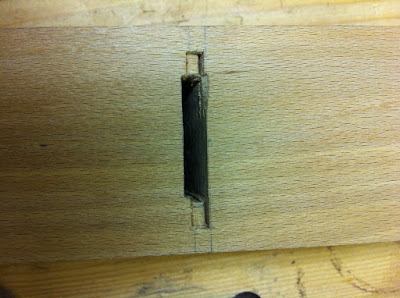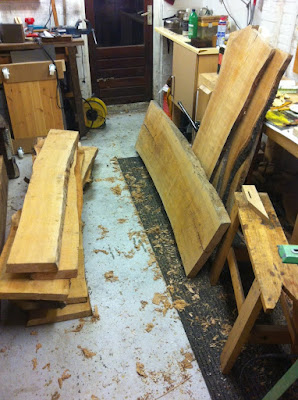Nobody wished me luck. So that's probably the reason why I failed. I made about 3 critical mistakes, one is rather uncorrectable.
When drilling from the mouth up I stupidly didn't border the mouth with chisel strikes first. The result: splintering. I also touched with the drill chuck, resulting in a dimple in the sole. Both these caused an increase in mouth size. Not a critical failure in a jack plane, more cosmetic. The drilling also looked like a drunk had speared through the plane, I had to raise the wear angle to 90 degrees to get rid of all the drillbit damage.
In the picture you can see the damage around the mouth from carelessness.
But the deal breaking error happened during morising the mouth. The chisel wandered way too much to the outside and cut away too much in the area where the abutments are supposed to be. Easy to see the gap under to the wooden wedge template. I don't think I can save this, the hollow is just too much.
So, today I prepared another beech blank. My beech is really very close to final size, so I prepare it with handplanes. You can be a lot more carefull with a handplane then with the planer/thicknesser.
Checking with winding sticks.
I also made a "new" abutment saw today. I used a piece from an old panel saw, cut with the angle grinder and a thin cut off blade. Stick it in a piece of ash and shape it for comfort. The blade is attached with some M3 nuts and screws. All very simple. Removed all the set and sharpened it up, rip cut, zero degree rake angle. I tried it in the failed plane attempt, and it works very well. Slow, and it likes to bind in the cut, so I need to wax the blade, but it results in a very precise cut.
And then I got another cutting blade for the new plane. This one is a little wider, so I also wanted a little wider blade. I happened to have a 57 mm (2 1/4") blade where a previous owner had ground down the sides at the cutting end to something like 55 mm width. I finished that all the way to the top and added a bit of taper, so it now runs from 55 at the bottom to 54 at the top. Lots of grinding!
And here they are, waiting for more labour. (Why does my bench always look like a warzone?)




































